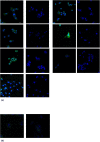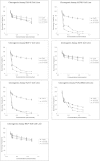A new hexapeptide from the leader peptide of rMnSOD enters cells through the oestrogen receptor to deliver therapeutic molecules
- PMID: 26725847
- PMCID: PMC4698655
- DOI: 10.1038/srep18691
A new hexapeptide from the leader peptide of rMnSOD enters cells through the oestrogen receptor to deliver therapeutic molecules
Abstract
A 24-amino acid leader peptide of a new human recombinant manganese superoxide dismutase can enter cells and carry molecules. Here, we demonstrated that six of the 24 amino acids penetrate cells through a particular gate represented by a specific amino acid sequence of the oestrogen receptor (ER). We analysed the internalization of the synthetic hexapeptide and the cytotoxic activity of the hexapeptide conjugated to cisplatin on a cell line panel. In most cell lines, the hexapeptide delivered an amount of cisplatin that was 2 to 8 times greater than that released by cisplatin when the drug was used alone. This increased delivery increases the therapeutic index of cisplatin and reduces side effects caused by a high dosage or long-term treatment times. We may consider this hexapeptide a new molecular carrier to deliver molecules with therapeutic activity into ER(+) cells for diagnostic purposes and clinical or immune therapy.
Conflict of interest statement
Yes, there is potential competing interest because Dr Aldo Mancini is the founder of Laedhexa Biotechnologies Inc.
Figures




Similar articles
-
The leader peptide of a human rec. MnSOD as molecular carrier which delivers high amounts of Cisplatin into tumor cells inducing a fast apoptosis in vitro.Int J Cancer. 2011 Jan 15;128(2):453-9. doi: 10.1002/ijc.25334. Epub 2010 Mar 22. Int J Cancer. 2011. PMID: 20309937
-
A molecular carrier to transport and deliver cisplatin into endometrial cancer cells.Chem Biol Drug Des. 2012 Jul;80(1):9-16. doi: 10.1111/j.1747-0285.2012.01337.x. Epub 2012 Apr 27. Chem Biol Drug Des. 2012. PMID: 22260094
-
Biophysical and biochemical characterization of a liposarcoma-derived recombinant MnSOD protein acting as an anticancer agent.Int J Cancer. 2008 Dec 1;123(11):2684-95. doi: 10.1002/ijc.23791. Int J Cancer. 2008. PMID: 18798256
-
A synthetic peptide mediated active targeting of cisplatin liposomes to Tie2 expressing cells.J Control Release. 2009 Nov 3;139(3):174-81. doi: 10.1016/j.jconrel.2009.06.024. Epub 2009 Jul 1. J Control Release. 2009. PMID: 19576253
-
Superior antitumor efficiency of cisplatin-loaded nanoparticles by intratumoral delivery with decreased tumor metabolism rate.Eur J Pharm Biopharm. 2008 Nov;70(3):726-34. doi: 10.1016/j.ejpb.2008.06.016. Epub 2008 Jun 26. Eur J Pharm Biopharm. 2008. PMID: 18634874
Cited by
-
A Gel Formulation Containing a New Recombinant Form of Manganese Superoxide Dismutase: A Clinical Experience Based on Compassionate Use-Safety of a Case Report.Case Rep Ophthalmol Med. 2016;2016:7240209. doi: 10.1155/2016/7240209. Epub 2016 Aug 17. Case Rep Ophthalmol Med. 2016. PMID: 27610257 Free PMC article.
-
Innexin hemichannel activation by Microplitis bicoloratus ecSOD monopolymer reduces ROS.iScience. 2024 Mar 18;27(4):109469. doi: 10.1016/j.isci.2024.109469. eCollection 2024 Apr 19. iScience. 2024. PMID: 38577101 Free PMC article.
-
Differentiation-Dependent Effects of a New Recombinant Manganese Superoxide Dismutase on Human SK-N-BE Neuron-Like Cells.Neurochem Res. 2019 Feb;44(2):400-411. doi: 10.1007/s11064-018-2686-5. Epub 2018 Nov 23. Neurochem Res. 2019. PMID: 30471001
-
The structure-function relationships and physiological roles of MnSOD mutants.Biosci Rep. 2022 Jun 30;42(6):BSR20220202. doi: 10.1042/BSR20220202. Biosci Rep. 2022. PMID: 35662317 Free PMC article. Review.
-
Current, emerging, and potential therapies for non-alcoholic steatohepatitis.Front Pharmacol. 2023 Mar 30;14:1152042. doi: 10.3389/fphar.2023.1152042. eCollection 2023. Front Pharmacol. 2023. PMID: 37063264 Free PMC article. Review.
References
-
- Wan X. S., Devalaraja M. N. & St Clair D. K. Molecular structure and organization of the human manganese superoxide dismutase gene. DNA Cell Biol 13, 1127–1136 (1994). - PubMed
-
- Wispe J. R. et al. Synthesis and processing of the precursor for human mangano-superoxide dismutase. Biochim Biophys Acta 994, 30–36 (1989). - PubMed
-
- Scott M. D., Meshnick S. R. & Eaton J. W. Superoxide dismutase amplifies organismal sensitivity to ionizing radiation. J Biol Chem 264, 2498–2501 (1989). - PubMed
-
- Mashiba H. & Matsunaga K. Device for intracellular increase of oxygen free radicals and inhibition of MethA tumour cell proliferation: in vitro and in vivo studies. Int J Tissue React 10, 273–280 (1988). - PubMed
MeSH terms
Substances
LinkOut - more resources
Full Text Sources
Other Literature Sources

